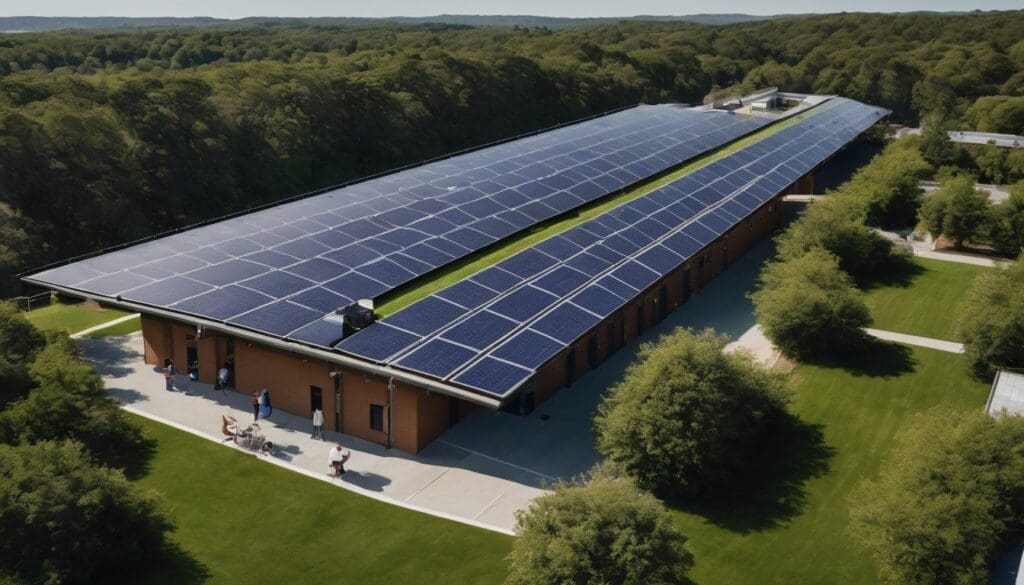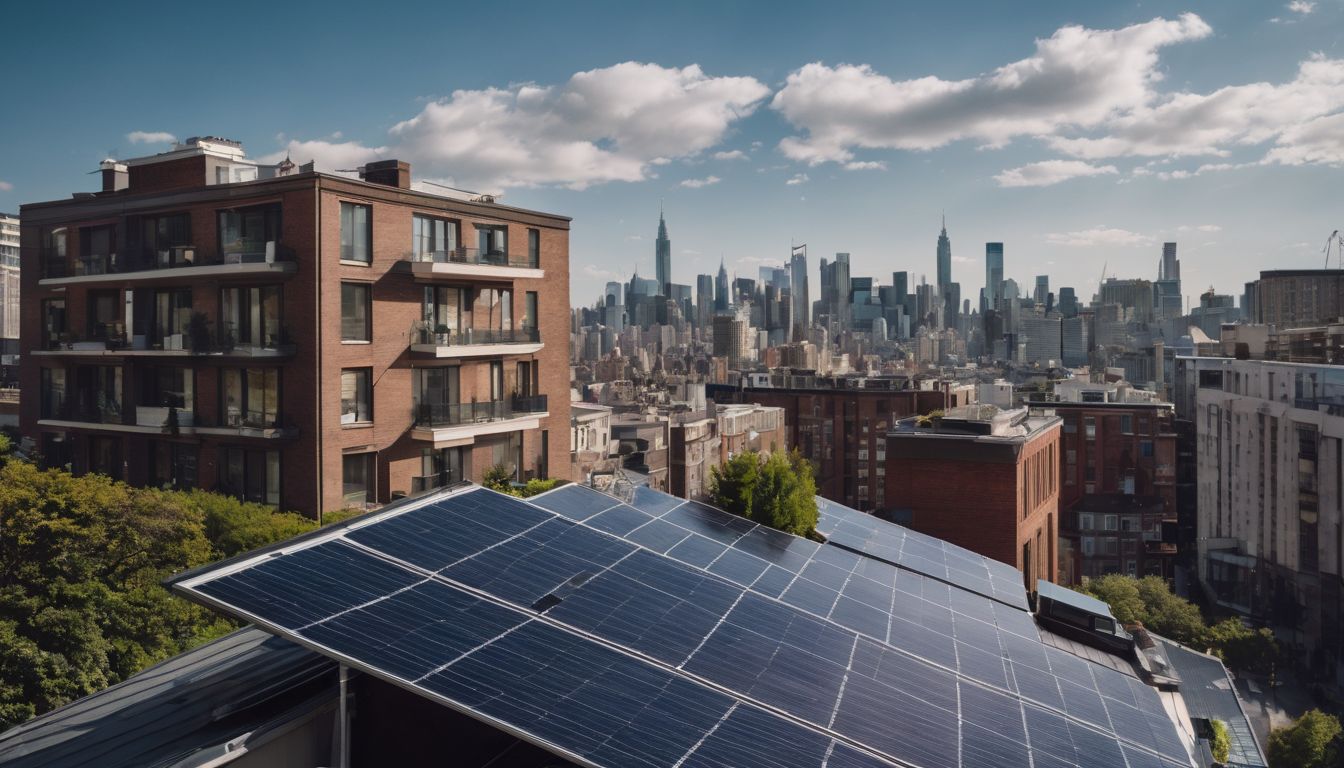Rising energy costs are a concern for schools, squeezing already tight budgets. Remarkably, solar power in educational institutions can slash electricity bills by up to 75%. This blog will reveal how harnessing the sun’s energy benefits both school finances and student learning.
Discover the bright side!
Key Takeaways
- Solar panels can cut school electricity bills by up to 75%, allowing funds to be used instead for educational resources or facility improvements.
- Excess energy from solar installations can potentially be sold back to the grid, creating a new revenue stream for schools.
- Adopting solar power helps reduce a school’s carbon footprint and reliance on non – renewable energy sources while demonstrating sustainability in practice.
- Solar education provides hands – on learning experiences, teaching students about renewable energy and how solar technology works.
- Schools play an essential role in improving their communities by embracing green initiatives that lead to cleaner environments and inspire local sustainable development.
Financial Benefits of Solar Panels for Schools
Solar panels offer schools significant cost savings on energy bills, allowing them to reallocate funds towards educational resources. Additionally, schools can potentially generate revenue by selling excess energy back to the grid.
Cost savings on energy bills
Schools that install solar panels can cut down their electricity expenses significantly. With the sun providing free energy during daylight hours, educational institutions rely less on grid power and more on clean, renewable electricity generated from their rooftops.
This transition to solar energy not only reduces reliance on fossil fuels but also slashes monthly utility bills. The savings made can be redirected into school programs or facility upgrades.
Investing in solar power for educational facilities turns them into eco-friendly learning centers while keeping operational costs low. Over time, the initial cost of installing a rooftop solar project is offset by the continuous reduction in energy expenses—providing long-term financial relief for schools operating under tight budgets.
Moreover, these cost savings serve as a tangible example of sustainability’s economic benefits alongside its environmental advantages.
Potential revenue from excess energy
Schools can potentially generate revenue from excess energy produced by solar panels. This surplus energy, when not used on-site, can be fed back into the grid and sold to utility companies, providing an additional income stream for the educational institution.
This extra income can then be reinvested into further sustainability efforts or other educational initiatives, ultimately benefiting both the school and the wider community.
By leveraging excess energy through solar power generation, schools contribute not only to their own financial sustainability but also play a part in promoting cleaner energy practices within their local area.
Environmental Impact of Solar Energy in Schools
Solar energy in schools reduces the carbon footprint and provides a clean, renewable energy source for educational institutions. This sustainable energy option helps to promote environmental conservation and reduce reliance on non-renewable resources.
Reduced carbon footprint
Switching to solar power in educational institutions reduces the carbon footprint by decreasing reliance on fossil fuels. This move helps to mitigate climate change by reducing greenhouse gas emissions, contributing positively to the environment and promoting sustainability within schools.
Embracing solar energy showcases a commitment to clean, renewable energy sources and sets an example for students and the wider community.
Implementing solar technology in schools provides a hands-on learning experience while demonstrating practical solutions towards environmental conservation. It also fosters a sense of responsibility towards sustainable energy practices among students, leading them towards becoming environmentally conscious citizens who understand the importance of reducing their carbon footprint through alternative energy sources like solar power.
Clean, renewable energy source
By harnessing the power of solar energy, schools and educational institutions can embrace a clean and renewable energy source. Solar panels provide a sustainable alternative to traditional electricity, reducing reliance on fossil fuels and decreasing carbon emissions.
This eco-friendly approach not only contributes to environmental conservation but also sets a positive example for students, encouraging them to support sustainability in their communities.
Implementing solar technology in educational facilities offers an opportunity to educate young minds about the importance of clean energy and inspire them to be advocates for a greener future.
Incorporating solar power into school infrastructure not only reduces environmental impact but also fosters a culture of innovation and responsibility among students, staff, and the wider community.
Educational Opportunities for Students
Students have the chance to engage in hands-on learning about renewable energy and gain a deeper understanding of how solar panels work. This provides an excellent opportunity for students to participate in real-world applications of sustainable technology.
Hands-on learning about renewable energy
Students at schools and educational institutions can engage in hands-on learning about renewable energy. They can participate in various activities that allow them to understand the concept of solar energy and its benefits. This active engagement fosters a deeper understanding of sustainability and clean energy, preparing students to be environmentally conscious individuals. They can also learn how solar panels work by taking part in projects that involve designing, assembling, and installing solar panels in designated areas on campus.
Understanding how solar panels work
Solar panels work by capturing sunlight and converting it into electricity using photovoltaic cells. When sunlight hits the solar panels, the photons in the light are absorbed by the semiconducting materials within each cell, creating an electric field.
This electric field allows for the flow of electricity, which is then harnessed as a direct current (DC) and converted into alternating current (AC) through an inverter. Once converted to AC, this electricity can be used to power lights, appliances, and other electrical devices in schools and educational institutions.
Solar energy is a clean and sustainable source of power that significantly reduces reliance on non-renewable resources like coal or natural gas. By understanding how solar panels work, schools can actively engage students in learning about renewable energy technology while promoting environmental conservation within their communities.
Steps for Schools to Get Started
To get started with solar power, schools should first conduct a feasibility study to determine the potential for rooftop solar projects. Once the study is complete, schools can secure funding for installation and select a reputable solar installer to carry out the project.
Ongoing maintenance of the system is also crucial for long-term success.
Conduct a feasibility study
To assess the viability of integrating solar power, schools must conduct a feasibility study. This involves evaluating the school’s energy needs, available space for solar panels, and potential cost savings.
The study also considers the environmental impact and educational opportunities for students. By analysing these factors, schools can make informed decisions about whether solar power is a practical and beneficial option for their institution.
The feasibility study enables schools to understand the financial implications, environmental benefits, and educational potential of adopting solar energy. It provides valuable insights that guide decision-making processes regarding sustainability initiatives in educational institutions.
Secure funding for installation
Schools can secure funding for solar panel installation through grants, rebates, and financing options. Look into government programmes that provide financial support for renewable energy projects in educational institutions.
Seek partnerships with local businesses or organisations that may be interested in sponsoring the installation of solar panels on your school’s premises.
Consider exploring community fundraising initiatives to garner support from parents, alumni, and other stakeholders who value sustainability and clean energy. Engaging with these avenues can help schools overcome financial barriers and make the transition to solar power a reality.
Select a reputable solar installer
To ensure the successful installation and maintenance of solar panels, educational institutions must carefully select a reputable solar installer. By conducting thorough research and seeking recommendations, schools can identify an experienced and certified installer with a proven track record in delivering high-quality solar energy systems for educational facilities.
It’s essential to collaborate with installers who have a deep understanding of the specific energy needs and sustainability goals of schools, enabling them to tailor efficient and cost-effective solar solutions that align with the institution’s environmental initiatives.
Moreover, partnering with a reputable solar installer can provide access to valuable guidance on system design, equipment selection, regulatory compliance, and ongoing support to maximise the long-term benefits of integrating clean energy into educational institutions.
Incorporating renewable energy into school campuses highlights the commitment to environmental stewardship while empowering students by demonstrating sustainable practices in action.
Maintain the solar system
After the installation of solar panels, regular maintenance is key to ensuring optimal performance. It involves cleaning the panels regularly to remove dust and debris that may hinder their efficiency.
Schools should also monitor the system for any signs of damage or malfunction, and promptly address any issues to avoid downtime.
Periodic inspections by a professional solar technician are recommended to identify and resolve potential problems early on. Additionally, schools should establish a routine schedule for checking energy production levels and monitoring for any unusual fluctuations.
By maintaining the solar system diligently, educational institutions can maximise cost savings and uphold their commitment to sustainable energy practices.
Future of Solar Power in Schools
The future of solar power in schools is promising, with a growing trend in K-12 institutions and the potential for more schools to go solar, incorporating solar education into their curriculum and benefiting the wider community.
To learn more about how solar power can benefit educational institutions, continue reading our blog.
Growing trend in K-12 schools
Schools across the country are increasingly turning to solar power as a sustainable energy solution. Integrating solar technology into K-12 schools is becoming more prevalent, offering numerous benefits such as significant cost savings and reduced environmental impact.
This shift towards solar energy in educational institutions presents an opportunity for students to engage with renewable energy firsthand, providing valuable learning experiences that align with the push for sustainability in education.
With an emphasis on integrating clean energy into curriculum and creating environmentally conscious school communities, the trend of adopting solar power in K-12 schools is expected to continue gaining momentum over the coming years.
Potential for more schools to go solar
The growing trend in K-12 schools adopting solar power indicates the potential for more educational institutions to go solar. Integrating solar energy into school facilities provides an opportunity to reduce environmental impact, cut costs, and provide valuable hands-on learning experiences for students.
As this movement gains momentum, opportunities emerge to incorporate solar education into the curriculum, benefiting both the wider community and future generations.
With sustainability at the forefront of many educational agendas, there is a significant opportunity for more schools and learning centers to embrace clean energy initiatives. By doing so, they can play a pivotal role in promoting renewable energy adoption and ecological responsibility within their communities.
Incorporating solar education into curriculum
Schools have the opportunity to integrate solar education into their curriculum, providing students with valuable insights into sustainable energy. Educators can incorporate lessons about solar power, teaching students about the environmental benefits and practical applications of renewable energy.
By including solar technology in their learning plans, schools can equip students with the knowledge and skills needed to support clean energy initiatives in the future.
Introducing solar education early on can inspire a new generation of environmentally conscious individuals who understand the importance of conservation and sustainable practices. These educational efforts contribute to a wider community understanding of clean energy solutions.
Benefits for the wider community.
Schools that adopt solar power systems not only benefit themselves but also contribute positively to the wider community. By reducing reliance on non-renewable energy sources, educational institutions lower overall carbon emissions and air pollution, leading to cleaner and healthier environments for everyone.
Additionally, as schools install more solar panels, they support the growth of green technology and renewable energy in their local areas, inspiring other organisations to follow suit and accelerating the transition towards a more sustainable future.
The integration of solar education into school curriculums further fosters awareness and understanding of environmental issues among students, who are then able to positively influence their communities.
Conclusion
In conclusion, embracing solar power in educational institutions opens up exciting opportunities for students to learn about renewable energy. Installing solar panels not only reduces energy costs but also sets a positive example of sustainability for the wider community.
Encouraging schools to integrate solar technology into their curriculum is a key step towards building a more environmentally conscious future. Embracing clean and renewable energy sources in schools is crucial for creating a greener and more sustainable environment for current and future generations.
FAQs
1. What are the benefits of solar power for schools?
Solar energy offers schools clean energy, helps them save on electricity costs, and provides educational opportunities as they learn about renewable energy and going green.
2. Can solar panels help make a school more sustainable?
Yes! Integrating solar technology in educational facilities promotes sustainability in schools by using eco-friendly power from the sun.
3. How does integrating solar power in educational institutions help the environment?
Using solar panels for educational facilities reduces reliance on fossil fuels, leading to cleaner air and less environmental impact from traditional energy sources.
4. Are there learning advantages to having solar power at schools?
Educational opportunities with solar energy include hands-on learning about green technology, environmental education, and preparing students for future careers in renewable energy sectors.
5. Will installing solar panels lead to cost savings for schools?
Absolutely! Clean energy from Solar Power can significantly cut electricity bills allowing educational institutions to allocate funds better towards student resources and programs.





